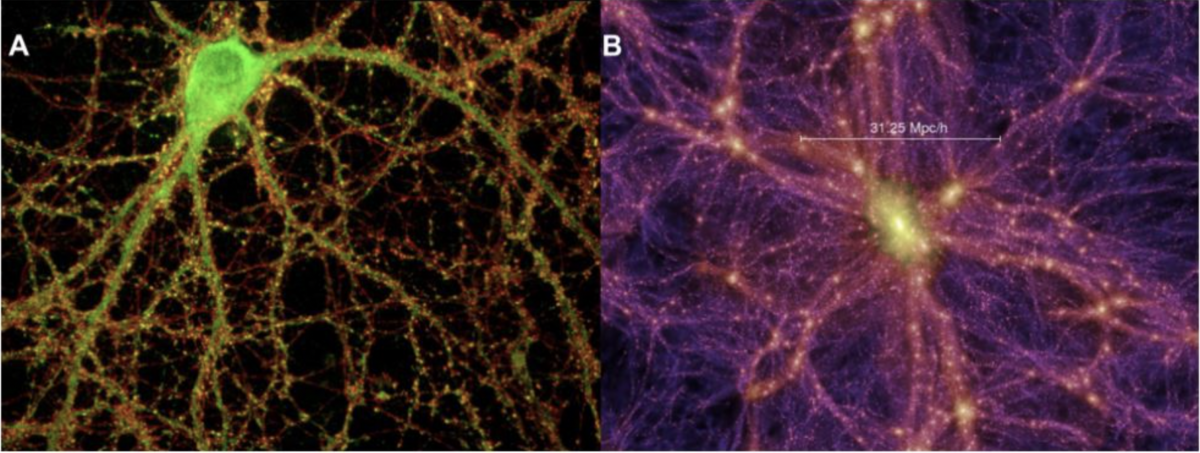A Conscious Universe

There is a phenomenon in physics called the Double Slit experiment. In it, photons of light are passed through two slits and measured on a subsequent film. After many photons of light are sent through each slit, the end film result shows the photons act like waves, passing through both slits at once. This leaves a spectrum of many equidistant light marks where the two waves combine to amplify the light, with intermittent dark spots where the two waves cancel each other out.
When Physicists then place a monitor to track each fired photon one by one to see which photon went into which slit, the end results on film are entirely different. There are just two marks on the film where each photon went through each slit. The final takeaway to scientists is that light behaves like a wave when it is not being watched and acts like a particle when it is being watched. The act of observing fundamentally changes the behavior of the photon… as if the photon knows it is being watched!
It might seem obvious, but it turns out there is actually a constantly changing debate in the science community as to what is actually alive and what is not. In order to be alive something must grow, develop, metabolize, reproduce, and/or be sentient. But think about it – fire grows, develops and metabolizes the fuel it consumes. Even Artificial Intelligence (AI) Applications are metabolizing electricity, growing and developing by programming itself, and may be even sentient (ChatGPT can easily pass the Turing Test). Plants and trees do the first four things, is it that far-fetched to add sentience? I wrote about a somewhat recent discovery of the Iron Sulfide World Hypothesis that theorizes rocks at the bottom of the ocean may have metabolized and reproduced to create the first organic cells that created the basis for all life on Earth. So yeah, rocks might qualify for being considered living beings too.
So what then is alive?
Walk around slowly and be present. You may see or sense that nearly everything is alive. The more aware you are, the more apparent it will become.
Through a biological lens, the purpose of life is to survive: Propagate your species through reproduction. Iterate for diversification against disease, famine, and the general unknown Force Majeure. Have your needs met to continue this process indefinitely. Millions of species on Earth have achieved this result, although now more than 20 a day face extinction due to the rapidly changing conditions of Earth’s new human-driven climate era known as the epoch Anthropocene.
But is it really the ultimate purpose of living beings in the universe… just to… survive? It is no doubt an impressive feat for a species to find its fit in the spectrum of scarce resources and ever-present competition. For every species that finds its niche, a hundred or a thousandfold of other species-iterations hit their dead end. Achieving the success of surviving in perpetuity is a huge accomplishment. But if it’s not the end goal, what comes next?
Carl Sagan once famously said, “We are a way for the universe to know itself.”
If a photon is sentient enough at some primitive level to know when it’s being observed, if rocks, electric telephone lines, computer processors, plants, animals, and trees could exude any sort of sentience, then perhaps consciousness is built brick by brick on the quantum level, and in all matter, across the entire universe. As those building blocks continue their iteration into more complex beings, like ones with large frontal cortexes (humans), that sophistication of deeper sentience only grows. Humans witnessed and named the universe “universe” after all.
This may explain why a heart transplant often gives the character traits of the donor to the recipient. Or that we can feel intuition in our gut. Consciousness is not just something in our brain, but perhaps all throughout and all around us. Something that we both swim in and are made of entirely.
The designs and evolution of life are being fueled by the universe’s own drive to know itself, to see itself, to feel itself, to clamor in seemingly endless iterations in order to become itself. And this is baked into the fabric of all matter across the universe. Maybe the ultimate purpose of a living species is to finally one day arrive as the reproduction of the universe to be born again anew. To be a brain, that contains in it, the entire cosmos. But that might be a few quadrillion years from now.
Since December 2021, the James Webb Space Telescope (JWST) hovers in the perpetual shadow of Earth capturing clusters of far away dimly lit galaxies, and their connected filaments of matter and dark matter. A complex species engineered both the hardware and software required to capture the physical images it captures. Those images are then sent back to Earth (by design) to be interpreted by human brains as inspiration, awe, curiosity, and feelings of what the universe itself is like. It makes people cry, write poetry, make YouTube videos, or be inspired to try harder in school in order to one day grow up to be a scientist. The images seem to mimic the same photos taken when a microscope snaps photos of neurons in the brain.
The entire known universe is observed to look like a brain and may be conscious like a brain.
